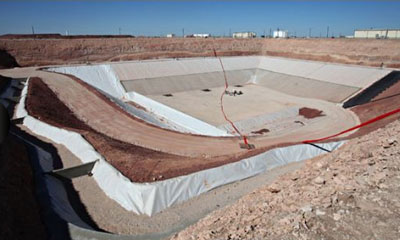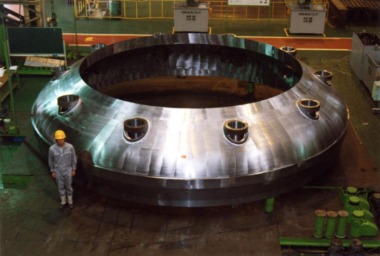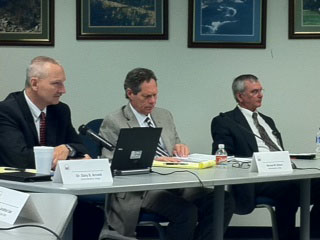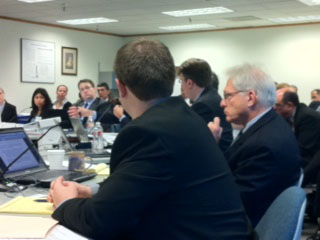Author Archive
Officials prepare for opening of radioactive waste facility
November 10, 2011
BY JON VANDERLAAN
OA Online

The radioactive waste disposal facility outside of Andrews, the first of its kind in Texas and one of three in the United States, celebrated its ribbon cutting Thursday.
Rod Baltzer, president of Waste Control Specialists, which operates the low-level radioactive waste disposal facility in Andrews County, said he’s been with the company since 1998, just three years after it began its involvement in the project.
"It’s a tremendous accomplishment," he said of the first facility in the United States that is licensed with the Nuclear Regulatory Commission for disposing of the low-level radioactive waste.
Regularly, radioactive waste is transported from holding facility to holding facility without actually being disposed, but the Andrews facility will take waste from 36 states around the country.
WCS Vice President Linda Beach said the standards upheld by the facility are much higher than previous radioactive waste disposal facilities.
"Some say we’re going to contaminate the Ogallala Aquifer," she said. "Science, technology and logic is not going to sway them because of what they believe."
In fact, she said, the facility is 10 miles away from the aquifer and will never threaten to contaminate the source.
Not only are the Texas Commission on Environmental Quality and other agencies constantly checking up on the facility, but several layers of protection in the way of concrete, grout and red bed clay keep radioactive materials from the outside.
The project is also tightly intertwined with the Texas government, which owns the land and will be pulling in tax revenue from in- and out-of-state companies that dump at the site.
Baltzer said the site will begin taking radioactive material at the commercial landfill in January. It already takes radioactive waste at a federal landfill and takes radioactive byproduct, all on the same site.
This document contains copyrighted material whose use has not been specifically authorized by the copyright owner. SEED Coalition is making this article available in our efforts to advance understanding of ecological sustainability, human rights, economic democracy and social justice issues. We believe that this constitutes a "fair use" of the copyrighted material as provided for in section 107 of the US Copyright Law. If you wish to use this copyrighted material for purposes of your own that go beyond "fair use", you must obtain permission from the copyright owner.
ABWR fit for aircraft impact
November 02, 2011
World Nuclear News
American safety regulators have certified an amended version of the Advanced Boiling Water Reactor (ABWR), opening the door for its construction at the South Texas Project (STP) and other US sites.
The ABWR was originally co-developed by GE and Toshiba and then constructed in Japan by those two in cooperation with Hitachi. That design was granted design certification by the Nuclear Regulatory Commission (NRC) in 1997 and includes certain proprietary engineering belonging to the merged nuclear business of GE-Hitachi.
Toshiba subsequently developed its own variant on the certified ABWR design for constuction at units 3 and 4 of the existing STP site. This design was submitted to the NRC in June 2009, and had to meet new aircraft impact rules which the regulator had codified in March of that year.
Yesterday’s certification means that the Toshiba version of the ABWR would be considered safe even if one were to be hit by a large civilian aircraft. Following such an impact, only minimal operator input should prove necessary in order to keep the reactor core cooled, and to maintain integrity and cooling at the used fuel pools.

An ABWR bottom petal forging, made by Japan Steel Works and earmarked for new-build at the South Texas Project. The forge has nearly completed the major forging sets for the two planned reactors
(Image: Japan Steel Works)
Plans to build two of these variant ABWRs at the existing STP site date back some time, with STP Nuclear Operating Company (STPNOC) and then partners NRG applying for a construction and operating license in 2007 and the next year choosing Toshiba as technology partners and lead contractor. These were slated to be the first ABWRs constructed in the USA.
Blaming the accident at Fukushima Daiichi for uncertainties in nuclear new build in the USA, NRG pulled out of the project in April this year, casting serious doubt on the project’s future. However both the COL application and the design certification process have remained active. The just-announced reactor certification will become effective 30 days after its publication in the Federal Register.
This document contains copyrighted material whose use has not been specifically authorized by the copyright owner. SEED Coalition is making this article available in our efforts to advance understanding of ecological sustainability, human rights, economic democracy and social justice issues. We believe that this constitutes a "fair use" of the copyrighted material as provided for in section 107 of the US Copyright Law. If you wish to use this copyrighted material for purposes of your own that go beyond "fair use", you must obtain permission from the copyright owner.
Hearing on foreign ownership of proposed South Texas Nuclear Reactors
August 17, 2011

Atomic Safety and Licensing Board -Judges Gary Arnold, Michael Gibson, Randall Charbeneau

Hearing on the application to expand the South Texas Nuclear plant earing underway.
Intervenor’s Foreign Control Contention for Proposed South Texas Project nuclear reactors
Tepco Detects Nuclear Fission at Fukushima Dai-Ichi Station
November 02, 2011
By Tsuyoshi Inajima and Yuji Okada
Bloomberg Businessweek
Nov. 2 (Bloomberg) — Tokyo Electric Power Co. detected signs of nuclear fission at its crippled Fukushima atomic power plant, raising the risk of increased radiation emissions. No increase in radiation was found at the site and the situation is under control, officials said.
The company, known as Tepco, began spraying boric acid on the No. 2 reactor at 2:48 a.m. Japan time to prevent accidental chain reactions, according to an e-mailed statement today. The detection of xenon, which is associated with nuclear fission, was confirmed today by the Japan Atomic Energy Agency, the country’s atomic regulator said.
"Given the signs, it’s certain that fission is occurring," Junichi Matsumoto, a general manager at Tepco who regularly talks to the media, told reporters in Tokyo today. There’s been no large-scale or sustained criticality and no increase in radiation, he said.
Fission taking place in the reactor can lead to increases in radiation emissions and raises concerns about further leaks after another radioactive hot spot was discovered in Tokyo on Oct. 29. It’s possible there are similar reactions occurring in the No. 1 and No. 3 reactors, the other cores damaged at the station, Matsumoto said.
"Melted fuel in the No. 2 reactor may have undergone a sustained process of nuclear fission or re-criticality," Tetsuo Ito, the head of Kinki University’s Atomic Energy Research Institute, said by phone. "The nuclear fission should be containable by injecting boron into the reactor to absorb neutrons."
Loss of Cooling
Trade and Industry Minister Yukio Edano delivered a warning to Hiroyuki Fukano, the head of the Nuclear and Industrial Safety Agency, because the information on the discovery of xenon wasn’t passed to the prime minister’s office in a timely manner, Chief Cabinet Secretary Osamu Fujimura told reporters today.
Shares of Tepco declined 2.6 percent to close at 302 yen on the Tokyo Stock Exchange. They’ve fallen 86 percent since the disaster. The benchmark Nikkei 225 Stock Average was down 2.2 percent.
Eight months after the March 11 earthquake and tsunami wrecked the Fukushima Dai-Ichi plant, causing a loss of cooling and the meltdowns of three reactors, Tepco is trying to prevent further leakage of radiation that has spread across the world.
The incident, the worst atomic disaster since Chernobyl in 1986, was responsible for the biggest discharge of radioactive material into the ocean in history, according to a study from a French nuclear safety institute.
Evaluating Reactions
"We are evaluating whether there are many reactions or not or whether its stopped," Matsumoto said. The incident won’t affect its schedule of bringing the plant under control by the end of this year, Matsumoto said.
Yasuhiro Sonoda, a member of the ruling Democratic Party of Japan, on Oct. 31 drank a glass of filtered water from the Fukushima plant to demonstrate the situation is being brought under control.
Sonoda denied reporters’ claims it was a publicity stunt. "I drank it because there shouldn’t be any concerns about the water," he said. "I didn’t intend to say it’s completely safe by drinking it."
No significant changes in temperatures and pressures of the reactor and radiation levels at the site have been detected, said Hiroyuki Usami, a spokesman for Tepco.
Reactor Readings
The temperature of the bottom of the No. 2 reactor pressure vessel was 76 degrees Celsius (167 Fahrenheit) at 5 a.m. today, compared with 77.4 degrees a day earlier and 77.5 degrees two days ago, according to Tepco’s data. Radiation levels taken near the west gate of the plant have been stable at about 11 microsieverts per hour for the past few days, the data shows
Should fissioning have occurred the injection of boron will have stopped it, said Tadashi Narabayashi, a former reactor safety researcher at Toshiba Corp. and now a nuclear engineering professor at Hokkaido University.
Fissioning involves the splitting of atoms, which, in the case of certain uranium isotopes, can lead to an uncontrolled reaction and emittance of radiation.
Tepco and the government have said they are on track to bring the damaged reactors into a safe state known as cold shutdown by the end of the year.
Nuclear fission would be taking place in a "very restricted part" of the reactor, said Koganeya. The regulator believes fuel accumulated at the bottom of the pressure vessel and containment vessel is unlikely to start melting again, he said.
Damaged Reactors
Fukushima sustained major damage at four of its six reactor buildings at the Dai-Ichi plant, including the three core meltdowns and possible damage to a spent fuel pool.
The radioactive cesium that flowed into the sea from the plant was 20 times the amount estimated by Tepco, according to the Institute for Radiological Protection and Nuclear Safety, which is funded by the French government.
The oceanic study estimates 27,000 terabecquerels of radioactive cesium 137 leaked into the sea from the plant. The Fukushima station may have emitted more than twice the amount of radiation than estimated by the Japanese government at the height of the Fukushima accident, according to another study by the Atmospheric Chemistry and Physics journal.
Tepco has declined to comment on both studies.
–With assistance from Taku Kato, Sachiko Sakamaki and Takehiko Kumakura in Tokyo. Editor: Aaron Sheldrick
To contact the reporters on this story: Tsuyoshi Inajima in Tokyo at tinajima(at)bloomberg.net; Yuji Okada in Tokyo at yokada6(at)bloomberg.net
To contact the editor responsible for this story: Peter Langan at plangan(at)bloomberg.net
This document contains copyrighted material whose use has not been specifically authorized by the copyright owner. SEED Coalition is making this article available in our efforts to advance understanding of ecological sustainability, human rights, economic democracy and social justice issues. We believe that this constitutes a "fair use" of the copyrighted material as provided for in section 107 of the US Copyright Law. If you wish to use this copyrighted material for purposes of your own that go beyond "fair use", you must obtain permission from the copyright owner.
South Texas Project Hearing in Rockville, MD
October 31, 2011
South Texas Project Hearing in Rockville, MD

Hearing Announcement- U.S.NRC
Atomic Safety and Licensing Board
STP Evidentiary Hearing
October 31, 2011

Susan Dancer, of South Texas Association for Responsible Energy, is one of the Intervenors opposing proposed South Texas Project reactors, along with SEED Coalition and Public Citizen.

Attorney Bob Eye and energy efficiency expert Phil Mosenthal with Optimal Energy were impressive at the NRC hearing on October 31st in Rockville, Maryland!


